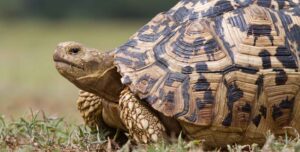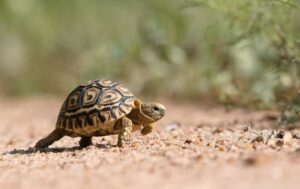Tortoises are fascinating creatures that have intrigued humanity for centuries with their slow, deliberate movements and longevity. One of the most common questions that arise when discussing these reptiles is, “How big do tortoises get?”
The size of tortoises varies greatly depending on their species. Some tortoises, like the tiny speckled padloper tortoise, only reach a few inches in length, while others, such as the Galapagos tortoise, can grow to enormous proportions, with some individuals weighing over 900 pounds and measuring over 5 feet in length.
Generally, tortoises can range from a few inches to several feet in size, with factors like habitat, diet, genetics, and species playing crucial roles in determining their ultimate size.
How big do tortoises get?

Tortoises come in various sizes depending on their species. They can range from small to very large, with some species being as small as a few inches long while others can grow to several feet in length and weigh hundreds of pounds. Let’s delve into some details:
- Smaller Tortoises: Some species, like the Russian tortoise (Agrionemys horsfieldii) or the Egyptian tortoise (Testudo kleinmanni), typically stay relatively small, reaching lengths of about 6 to 8 inches (15 to 20 centimeters) and weighing between 1 to 2 kilograms.
- Medium-sized Tortoises: Species such as the Hermann’s tortoise (Testudo hermanni) or the Greek tortoise (Testudo graeca) fall into this category. They can grow to lengths of around 8 to 12 inches (20 to 30 centimeters) and weigh between 2 to 5 kilograms.
- Large Tortoises: Some of the most well-known tortoises belong to this category. The African spurred tortoise (Centrochelys sulcata), for example, is one of the largest tortoise species. They can reach lengths of over 30 inches (75 centimeters) and weigh over 100 kilograms (220 pounds). Similarly, the Galapagos tortoise (Chelonoidis nigra), famous for its impressive size, can weigh over 400 kilograms (880 pounds) and reach lengths of up to 5 feet (1.5 meters).
- Giant Tortoises: This category includes some of the largest tortoises on Earth. The Aldabra giant tortoise (Aldabrachelys gigantea) and the Seychelles giant tortoise (Aldabrachelys hololissa) are examples. They can weigh over 250 kilograms (550 pounds) and reach lengths of up to 4 feet (1.2 meters).
Tortoises are known for their slow growth rate, and their longevity contributes to their potential to grow large over time. Factors such as diet, habitat, and genetics also play significant roles in determining their size. Additionally, captive tortoises may not grow as large as their wild counterparts due to differences in environmental factors and diet.
Factors Influencing Tortoise Size
The size of a tortoise is influenced by a combination of genetic, environmental, and health-related factors. Let’s delve deeper into each:
- Genetics: Just like with humans and other animals, genetics play a significant role in determining a tortoise’s size potential. Each tortoise species has its own genetic blueprint that dictates its maximum size range. Within a species, individual tortoises may inherit genes from their parents that influence their growth rate and ultimate size. This means that tortoises from larger parents are likely to be larger themselves, while those from smaller parents may have a smaller size potential.
- Diet: The diet of a tortoise directly impacts its growth rate and overall size. Tortoises are primarily herbivorous, and their diet should consist of a variety of leafy greens, vegetables, fruits, and occasional treats. A well-balanced diet provides the necessary nutrients for healthy bone and tissue growth. Inadequate nutrition can lead to stunted growth or health issues that affect size.
- Habitat: The environment in which a tortoise lives affects its growth. Tortoises require appropriate temperatures, humidity levels, and access to food and water to thrive. In the wild, factors such as habitat quality, competition for resources, and predation risk can influence growth rates. In captivity, providing a suitable habitat with proper temperature gradients, UVB lighting, and opportunities for exercise is essential for promoting healthy growth.
- Health: The overall health of a tortoise is crucial for optimal growth. Illnesses, parasites, injuries, or other health issues can impact appetite, nutrient absorption, and metabolic processes, all of which can affect growth. Regular veterinary check-ups and prompt treatment of any health concerns are important for ensuring that a tortoise reaches its full size potential.
- Age: Tortoises grow slowly over their lifespan, with growth rates typically slowing down as they age. Young tortoises experience more rapid growth compared to adults. Some species may reach their maximum size relatively quickly, while others continue to grow throughout their lives, although at a slower rate. Understanding the growth trajectory of a particular tortoise species is important for managing expectations regarding size.
- Sex: Sexual dimorphism, where males and females of the same species exhibit different physical characteristics, can influence size. In some tortoise species, males are larger than females, while in others, females are larger, or there’s little difference in size between the sexes. Hormonal differences between males and females can affect growth patterns, particularly during sexual maturity.
By considering these factors, tortoise owners can take appropriate measures to ensure the proper care and growth of their pets. Providing a suitable diet, habitat, and healthcare, along with understanding the natural growth patterns of the species, are essential for promoting healthy size development in tortoises.


